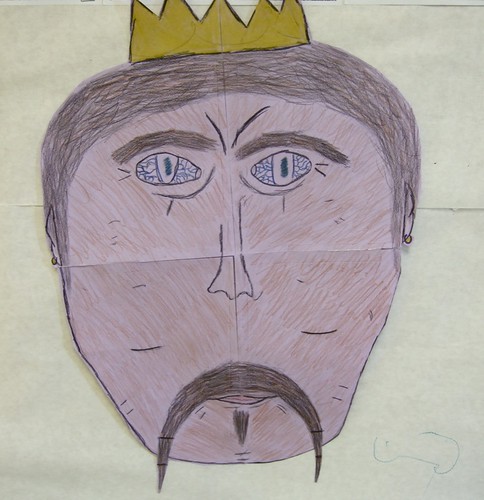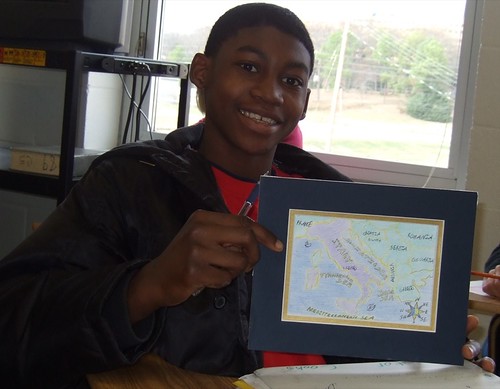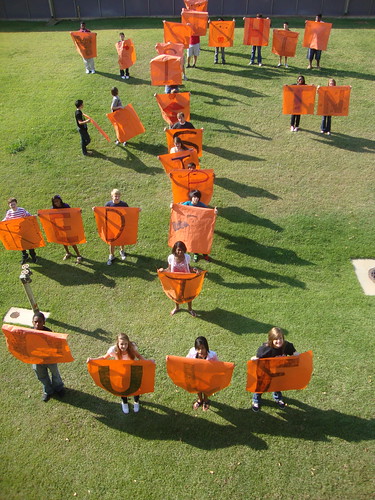King Cake Quiz
1. Louisiana's carnival season does not begin on a) Twelfth Night b) Epiphany c) Jan 6 d) Ash Wed.
2. Dionysian celebration: a) Greek b) Roman c) Persian.
3. Saturnalia: a) Greek b) Roman c) Persian.
4. Translate a) Carne: ___ b) vale: ___
5. Translate: "Lent."
6. Not one of the first 5 nations associated with carnival:
a) Italy b) Louisiana c) England d) Germany e) Spain
7. Earliest historic era in which Carnevale is written about: a) Medieval b) Renaissance c) Elizabethan.
8. One example of riotous Carnival behavior.
9. Shrove Tuesday: translate to "shrive:" __ __ __.
10. Female krewe of New Orleans.
11. European city that establishes the early carnival customs: a) Paris b) Venice c) London d) Munich.
12. First krewe of Louisiana.
Purple, green & gold quiz
1. Alabama location with considerable influence on New Orleans (NO) Carnival? The small city of __.
2. Public activity that was considered a basic pleasure of the pioneer days? ___
3. Slaves gathered on Sundays and danced in New Orleans in a special location, which was back of town. It was called __ __.
4. Louisiana's second oldest krewe?
5. Name one of the 3 customs established by Rex.
6. Etymology of “Rex:” in Latin it means __ .
7. List the chronological order of the founding of these crews: Comus, Rex and Zulu.
8. In Louisiana we call a cheap coin “throw” a __ .
9. Mardi Gras has neighborhood clubs that call themselves "gangs."
Are they a) MG Indians b) Drug organizations c) Brass bands.
10. When did jazz music begin? a) During the US Civil War b) about the turn of the century c) 1930's d) 1950's
11. What are the flambeaux? __
12. How long did French immigrants live in Nova Scotia before being expelled from the region they called Acadia and going on a journey that would take them to Louisiana? a) 50 b) 100 c) 200.
13. A French name for a community dance or a Cajun house party? a) a bon plaisir b) Laissez les bons temps rouler c) Fais do-do d) Mais, oui!
Tuesday, January 31, 2012
How To Mardi Gras quizzes: the King Cake Quiz and the Purple, Green and Gold Quiz
Saturday, January 28, 2012
Coates Bluff Nature Trail instruction / Magnet geography
There will be 2 follow-up activities:
1. Mult-choice quiz on the Flora & fauna sheet.
2. Essay on the walk. Your essay must be descriptive and detailed but you may choose between
- realistic reportage
or
- mixture of fact and fiction.
Monday, January 23, 2012
Postponement of walking field trip due to rain and cold; Mon or Wed will be better
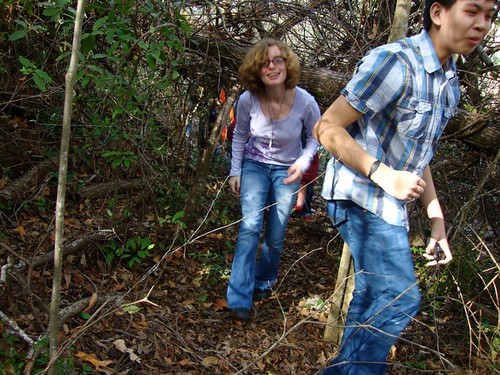
Magnet High geography students, Coates Bluff Nature Trail, Shreveport, a photo by trudeau on Flickr.
Parents are welcome to accompany us on nature walks to be taken Fri (and Th) on Coates Bluff Nature Trail.
It follows the dry Bayou Pierre river bed from Magnet to Montessori School for Shreveport.
Students will have a Flora and Fauna Identification sheet to use in their examination of the beautiful woods. Students will view a video interview with Caddo naturalist Larry Raymond prior to the walk.
Each group will depart within 5 mins of the beginning of class and will be back on campus before the bell. There will be no missed class.
Also, bring a healthy snack for bonus pts. Bring something that is not manufactured, please. An apple, banana, orange, some peanuts or raisins.
Colorful Carnival project: Mask or poster or float with informativeborder
Colorful Carnival cut-out project due Jan 23, 11 pts.
- Cut out and paste into the page the central design, whether float design, mask or other Carnival motif. Project stays in notebook - 8 1/2 X 11 sheet.
- Fill the border with factoids - completely round the central design - about Carnival and Lent.
- Masksoftheworld.com is one source for background on masks.
Sunday, January 22, 2012
Tuesday, January 17, 2012
The Roots of Carnival quiz
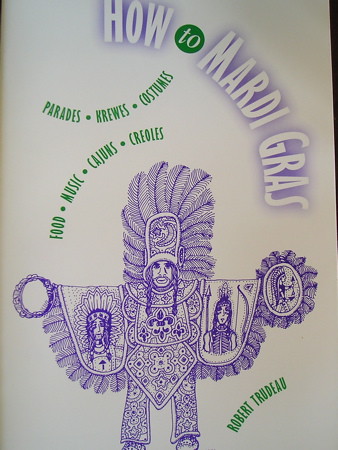
The most comprehensive guide to Louisiana's Carnival season: How To Mardi Gras, a photo by trudeau on Flickr.
1. New Orleans African heritage: a) West b) East c) North
2. translate: bons
3. translate: rouler
4. translate: laissez
5. translate: temps
6. translate: gras
7. Louisiana's carnival season does not begin on a) Twelfth Night b) Epiphany c) Jan 6 d) Ash Wed.
8. Dionysian celebration: a) Greek b) Roman c) Persian.
9. Lupercalia: a) Greek b) Roman c) Persian.
10. Translate a) Carne: ___ b) vale: ___
11. Translate: "Lent."
12. First 5 nations associated with carnival.
13. First historic era in which Carnevale is written about: a) Medieval b) Renaissance c) Elizabethan.
14. Examples (2) of riotous behavior.
15. Translate: Shrove Tuesday.
16. Female krewe in New Orleans.
17. Why were parades instututed in New Orleans about 1857?
18. Two European cities that estabish the early carnival customs.
19. First krewe of Louisiana.
20. Alabama location with considerable influence on New Orleans (NO) Carnival?
21. 2 differences between Alabama and NO celebrations.
22. Primary public activity that was considered a basic pleasure of the pioneer days?
23. The location of Congo Square in New Orleans?
24. Activities by slaves in Congo Square? Frequency?
25. The second oldest krewe?
26. 3 customs established by Rex.
27. Etymology of “Rex.”
28. Make a timeline of Comus, Rex and Zulu.
29. Cheap coin “throw”?
30. Mardi Gras has neighborhood clubs that call themselves "gangs."
Are they a) MG Indians b) Drug organizations c) Brass bands.
31. What organization is brought to mind by the phrase “two-way pocky way!”?
32. Blanc et Noir Marching Society will hire what sort of band for the Krewe of Highland parade?
33. When did jazz music begin?
34. In what kinds of bands did jazz begin?
35. Explain the meaning of the French term "boeuf gras."
36. What are the flambeaux?
37. A famous Louisianian signed his letters, “Red beans and ricely yours,” His name and nickname?
38. What is one of the themes of New Orleans costuming?
39. How long did French immigrants live in Nova Scotia before a journey that would take them to Louisiana?
40. Why are they called Acadians, or Cajuns?
41. What is the name for the Cajun Mardi Gras?
42. Another name for a Cajun house party?
43. What 2 types of music mingle in Zydeco?
44. What ethnic group created zydeco?
45. Make a small map featuring Europe, South America, Central America and North America. List nations in which we see a significant carnival celebration.
Monday, January 09, 2012
Unit 1, second semester: L'Italia, an overview for geography students
Tuscany is arguably Italy's best-known region. The history and beauty of the hilly farmland is legendary. Interestingly, Toyota has named its minivan the Sienna, for a Tuscan town, and Porsche has long had a model called the Carrera, another city of Tuscany. Also in the region: Pisa and Firenze.
My overview of what's important in L'italia:
In the heart of Rome is the temple called the Pantheon, still functioning after some 2000 years.
Ciao! means "hello!" or "bye!" in Italian slang.
From Chianti, a vino of Northern Italy, to chiaroscuro, an artist's term which refers to portrayal through light and shadow, the Italians have an enormous impact on the refined life.
On the other hand there's the Sicilian mafia, the cosa nostra.
The map
* Roma and, within it, the Vatican City. The Vatican is one of the tiniest nations and home to il Pape.
* Napoli / Naples / Neapolis (Gk) Neapolitan ice cream! Home of pizza!
* On the Bay of Naples is the Isle of Capri (goats), one of the most ancient resorts. One of Rome's emperors capriciously used Capri as his capital. *
* Looming above Naples bay is Mt. Vesuvius and nearby is the ancient resort called Pompeii.
* Florence / Firenze / "flower" is the center of the region called Tuscany. The Ponte Vecchio is a bridge over the River Arno which features shops built into the structure. "Florentine" indicates high quality in jewelry, in cooking, in crafts.
* The River Arno flows to the sea through Pisa, famous for its bell tower.
* Venetia / Venizia / Venice, is called the "Queen of the Adriatic." Is this where Venetian blinds originated?
* Milano is a center of the fashion industry and city of fine foods and complex recipes. That's why Pepperidge Farms named their light but fine and imperially slim cookie the Milano.
Why study Italy?
* Natural beauty: the Appenino range, the sea, the fertile fields of the Po River valley.
* History: the eras of the Roman Empire and the Renaissance were periods of extraordinary creativity.
* Cuccina, or cooking. From Fettucine Alfredo to Cannoli.
* Foods such as sausages (salami), olive oil and cheeses (ricotta, parmesan, provolone, mozzarella).
* Textiles and fashionable clothing, shoes and bags: Armani, Gucci, Dolce & Gabana, Prada, Versace, etc.
* Manufactured goods such as the Ferrari, Lamborghini, Lancia and Fiat.
* Art by Michaelangelo, Leonardo da Vinci, Donatello and numerous others.
* Vatican City: the tiny nation that is the center of power of the Roman Catholic church.
* The origins of musical art such as opera, ballet and instrument making. See the pianoforte and violincello.
**
Classroom music ...
"Carmina Burana:" secular Medieval tunes in an opera-like choral production (opera means a "work").
**
Tuscany: a region known for its history, landscapes, vineyards, flowers, fine cooking, art and historic towns such as Pisa, Siena and Lucca. Florence is Tuscany's capital.
Sienna, the orangish-red or brownish-yellow color, takes its name from the soil in Tuscany. See Terra di Siena and Terra Cotta ("baked earth") clay. Remember Roman tiles made of terra cotta?
What American region compares to Tuscany?
Napa Valley, California, above San Francisco bay. It is known for vineyards (Gallo, Almaden), fine cooking and hilly beauty.
Mortar & pestle - used by apothecary or chef to grind and blend herbs or medicines. Gives its name to Sauce Pesto.
Pesto sauce includes basil, parmesan cheese, olive oil, pine nuts (pignoli)and garlic. Pesto is herbally greenish and sweet. It is traditionally eaten over pasta.
Pasta: dough.
Did pasta come to Italy from Germany or China? Marco Polo was the likely importer of a recipe for the food, made simply of wheat (one type being semolina) and water.
Here are selected examples:
canelloni: stuffed tube.
capelletti: "little hats;" stuffed.
farfallette: ribbon/bow-shaped.
fettucine: long egg noodles.
lasagna: widest of the flat noodles.
linguini: "little tongues;" narrow.
macaroni: in tubes.
pastina: disks of pasta.
ravioli: filled squares.
rigatoni: ribbed, tubular.
tortellini: ring-shaped and filled.
vermicelli: "little worms;" thin.
**
Sicilian pastry: cannoli. Like ice cream in a tube.
Balsamic vinegar: tart, sweet, dark vinegar, usually combined with olive oil. Used in salads and over pasta.
Calamari: fried baby squid.
**
Italy in WWII
Benito Mussolini was the dictator of Italy who became a partner - creating the Axis powers - to Adolph Hitler. Both espoused Fascism:
a) totalitarian government b) militarism c) anti-Communist d) anti-intellectual. "Fascism" comes from the term for the bundle of rods used as a symbol of power by the Romans.
Italy was liberated in 1944 by the Allies: US, GB, France, Canada, Australia.
**
pianoforte "soft / loud"
* developed about 1700 by Bartolomeo Cristofori of Cremona, Italy.
* harpsichord plucks strings and has only one volume; piano hammers strings and can play loudly or softly.
violin
* Antonio Stradivari and the Guarneri family are the luthiers who develop the 4-string, advanced violin about 1700.
Most notable historic composers:
Giuseppi Verdi
Antonio Corelli
Giacomo Puccini
Antonio Vivaldi
Nicolo Paganini
Harmony Illus. Encyc. of Classical Music
According to Italian language student Chelsea Norden:
bella donna, "beautiful woman"
bell'uomo, "handsome man"
casa, "house"
Salve! "hello"
Buon giornio! "good day!"
Io amore tu, "I love you."
Scusi! "Excuse me!"
Prego, "please"
**
"Pinocchio," classic folk tale
**
Espresso & cappucino
The Italians make il caffe' by forcing steam through the grounds; it is called espresso. Drunk in a tiny cup called a demi-tasse, it is a strong brew. When you make a "cap" of whipped cream and grated chocolate to put atop the espresso it becomes cappucino.
Latte refers to the added milk. Frappe' means frozen or iced. Dip a hard biscuit, called biscotti, into it.
**
Can you name the Western European nations that were part of the Roman Empire? Espana, Gaul & Briton.
Our goal is to know the names of all the nations of the empire that were on the Mediterranean rim.
**
More basic Italian ...
Tu sei cortese! "You are so nice/courteous!"
Grazie! "Thank you!"
Dove 'e il bagno? "Where is the bathroom?"
Catherine d Medici, of the powerful family of Florence (think Rockefellers), married Henri II of France about 1500. She traveled to France with her Florentine cooks - with marvelous recipes - and the controversial custom of using a fork (furca).
In ancient times which class of people would've used all 5 fingers in eating? Which class ate with 3 fingers?
**
In what Roman facility would we see the caldarium, tepidarium and frigidarium? It was a Thermae, or public bathhouse.
The pools above were "hot," "tepid," or "lukewarm," and "cold." What could you do in a bathhouse besides wash and relax in the pools?
Exercise, hear the news, get a snack, have a massage and leave your laundry.
A Roman feast, according to Petronius and the World Atlas of Food: asparagus, truffles, eggs, olives, sausages, oysters and lobsters, for openers. Main dishes were stuffed geese and chickens and pigs, goose-liver pate' and stewed flamingo's tongues and peacock's brains.
Who is David Macaulay? A contemporary
illustrator/author responsible for books such as Cathedral (how they were built), Castle and the popular How Things Work.
This week we're watching a video called "Roman City," based on his book City. It's about the engineering (bridges, aqueducts, etc.), planning (city grid first) and functions (forum, bathhouses, etc.) of a Roman urbis.
**
The Roman Empire lay upon 3 continents. Which ones?
Romulus & Remus: who were they?
What plastic building material was developed by the Romans?
Concrete.
Intersection of the temples, market and government buildings? Place to disseminate news and opinion? The Forum.
Roman villa
A roof opening that allowed the sun and rain to enter the interior of the house? The atrium. The pool in the atrium was the impluvium.
The garden and vineyard flourished under the peristyle, or arbor.
Cave canem: Latin, "Beware the dog."
Cave emtor: "Let the buyer beware."
Roman apartment buildings: Insulae ("islands"). Multi-story buildings of concrete.
Tuesday, January 03, 2012
The semester exam includes a mandatory, brief essay - here are the topic choices
Choose one!
Comparison essay choices for the open-notes essay -
a) Henry Miller Shreve and Larkin Edwards
b) Adolph Hitler and Henry VIII
c) Quiche and the Chicago hot dog
d) The Mississippi and Rhine Valleys
Essay guidelines -
- Jally title
- Sloopy opening
- Integrate the topics.
- Details: examples, names, stats, dates, states, etc.
- Document!
About a half to one page, carefully, legibly handwritten.
The Miss Valley review for the exam
Sem exam questions
1. Westernmost river of the Miss valley?
2. The easternmost river of the Miss valley?
3. State in which we find the headwaters of the Miss?
4. State in which the Miss delta?
5. Longest tributary of the Miss?
6. To what eastern city does the Ohio extend?
7. Name the NE state that borders the Miss.
8. The SW state that borders the Miss.?
9. State through which the Tenn R enters the Miss?
10. Headwaters of La's Red R in which state?
11. Which body of water is the terminus of La's Red R?
12. State not associated w the Red?
13. Caddo chief?
14. Caddo translator?
15. Sustainability ? Using resources wisely. Being comfortable with the basic pleasures of life. Ex: Valencia Community Garden.
16. Migration of Indigenous peoples? Intermarriage with Black and white pop.
17. Migration of indigenous peoples? Ok
18. City w longest name?
19. City named for female?
20. Named for a royal person?
21. Named by a Native Amer word?
22. Two connectors between the Great lakes and NYC?
23. One island / one borough? Staten Is, also Manhattan
24. Two boroughs on one island? Brooklyn, Queens / Long Is
25. Borough on the mainland?
26. London is on the __ River.
27. Name the building that houses Parliament.
28. Name the theater partly-owned by Wm Shakespeare.
29. Name the bridge lined with shops that historically linked the North and South of the Thames River.
30. In the early 1800's a poor boy of London grew up to write successful novels about British life, such as Oliver Twist and A Tale of Two Cities. The author was Charles Dickens. The musical Oliver! is based on his novel. See a version of Oliver Jan 6, 7 or 8 at Riverview Theater.


